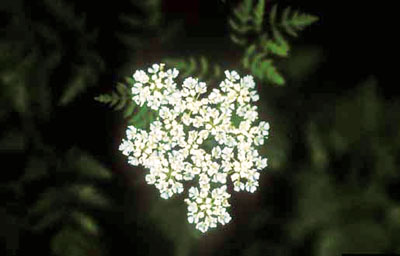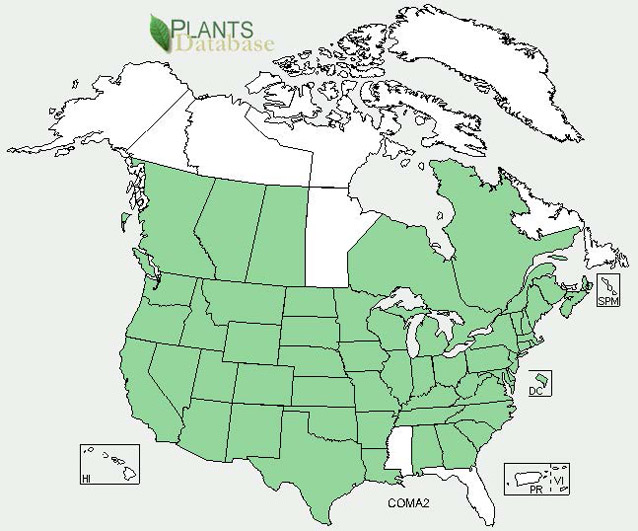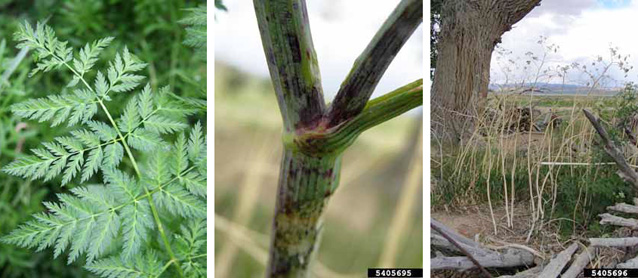Apiaceae (Carrot family)
At a Glance

© John Cardina / Ohio State University
- Biennial
- Stems with purple splotches grow two to ten feet tall
- Divided compound leaves that taper to a point
- White flowers are borne in umbrella-shaped clusters
- Fruit is egg-shaped in outline, with distinctive wavy ribs on the surface
- Highly toxic
Habitat and Ecology
Native to Europe, western Asia, and North America, poison hemlock (Conium maculatum) is now naturalized in almost every state in the United States. It was introduced in the 1800s as a garden plant, marketed as being a “winter fern”. Poison hemlock is highly poisonous to humans and animals. It can acts as a pioneer species and quickly colonized disturbed sites. Infestations occur along roadsides, field margins, ditches, marshes, meadows, and low-lying areas, but poison hemlock prefers shaded areas with moist soil.

USDA
Description
Poison hemlock is a highly toxic biennial with the musty, unpleasant odor associated with alkaloids. It grows two to ten feet tall. The stems are ribbed and hollow with purplish streaks or splotches. Poison hemlock reproduces by seeds that fall near the plant and disperse via fur, birds, water, and, to a limited extent, wind. Most seeds fall from September through December, but they can fall as late as the end of February. The seeds germinate in the fall, but the plant usually does not produce flowers until the second spring.
Leaves
The leaves have some resemblance to ferns. They are opposite and compound, with the leaflets divided into narrow segments. When crushed, the leaves emit a rank odor.

Left: © Robert Vidécki; Middle and right: Bonnie Million / NPS
Flowers and Fruits
The small, white or yellowish flowers have five petals that bloom above the ovary. The flowers are borne in many umbrella-shaped clusters at the end of the flower stalks. Underneath each cluster are four to six brown bracts. The fruit is egg-shaped in outline, with distinctive wavy ribs on the surface. It is composed of two dry halves, each with one seed, that eventually separate from each other. The fruit is 2-3 mm wide.
Etymology
Co’nium is derived from the ancient Greek name coneion, meaning hemlock. Macula’tum means spotted, referring to purple splotches on the stems of leaves or on petals.
Ethnobotany
Poison hemlock is highly toxic. Ancient Greeks used poison hemlock to execute prisoners—Socrates being the most famous example.
Similar Species
Poison hemlock looks similar to wild carrot (Daucus carota), wild parsnip (Pastinaca sativa), and water hemlock (Cicuta maculata). Wild carrot and wild parsnip do not have purple mottling on their stems. In addition, wild carrot has a hairy stem. Water hemlock does have purple mottling and hairless stems, but unlike poison hemlock, it has a cluster of fleshy taproots at the base.
Control Methods
Possible control methods are explained at these websites:
References
Arizona Wildlands Invasive Plant Working Group. 2004. Conium maculatum Plant Assessment Form.
Cardina, J., C. Herms, T. Kock, and T. Webster. No date. Poison hemlock in Ohio Perennial and Biennial Weed Guide. Ohio Agricultural Research and Development Center Extension. Available at http://www.oardc.ohio-state.edu/weedguide/singlerecord.asp?id=550 (accessed 22 March 2010).
Charters, M. L. 2009. California plant names: Latin and Greek meanings and derivations. Available at http://www.calflora.net/botanicalnames (accessed 22 March 2010).
Constance, L. 1993. Conium maculatum in Hickson, J. C., editor. The Jepson Manual: Higher plants of California. University of California Press, Berkeley, CA.
Drewitz, J. 2000. Conium maculatum in Bossard, C. C., J. M. Randall, and M. C. Hoshovsky, editors. Invasive plants of California’s wildlands. University of California Press, Berkeley, CA. Available at http://www.cal-ipc.org/ip/management/ipcw/pages/detailreport. cfm@usernumber=32&surveynumber=182.php (accessed 22 March 2010).
Pitcher, D. 1989. Conium maculatum in Element Stewardship Abstracts. The Nature Conservancy, Arlington, VA. Available at http://www.imapinvasives.org/GIST/ESA/esapages/documnts/conimac.pdf.
Prepared by Kelly Reeves, Southern Colorado Plateau Network Inventory and Monitoring Program, 2010.
Last updated: April 29, 2016
